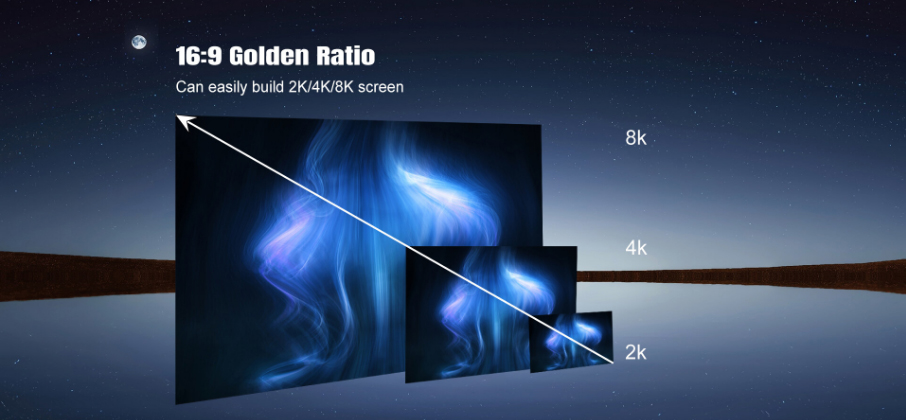What Is a Indoor Transparent LED Display and How Does It Work?
Introduction to Indoor Transparent LED Display
An indoor transparent LED display is a cutting-edge technology designed to provide vivid visual content while maintaining transparency, allowing light to pass through. It finds versatile applications in various indoor environments, offering a unique blend of aesthetics and functionality.
Technology Behind Transparent LED Displays
Transparent LED display is a display technology that uses light-emitting diodes (LEDs) to create images. Light from the LED is projected onto a transparent surface. This transparency allows for display on both sides of the screen.
Transparent LED displays consist of transparent LED panels that use advanced semiconductor technology. These panels are structured to emit light while enabling high transparency, achieved through pixel pitch—the distance between the centers of adjacent pixels.
How Transparent LED Displays Work
Transparent LED display is an upgraded version of standard LED screen. It's a display technology that uses transparent materials to create vivid, vibrant images. Therefore, it attracts the audience with content in the most attractive way. Additionally, they are cost-effective and easy to maintain.
A transparent LED display combines LED backlighting with transparent LCD glass. This unique combination allows light emitted by the LEDs to pass through the LCD glass, creating bright and clear images that appear to float in mid-air.
The LEDs in a transparent LED screens are arranged in a matrix and controlled by a dedicated controller. This controller sends signals to each individual LED, allowing for the formation of different images on the screen.
Moreover, transparent LED displays utilize millions of micro-LEDs (light-emitting diodes) sandwiched between two layers of membrane. The top layer is transparent, enabling light to pass through, while the bottom layer is reflective, directing light back towards the viewer's eyes. These LEDs emit light in various colors and brightness levels, which are combined to produce vibrant images and videos.
Additionally, transparent LED displays offer a wide viewing angle, allowing viewers to see images clearly from any perspective without distortion or blurring. This is achieved by turning off the LEDs behind the displayed image or video, while the front LEDs remain illuminated, maintaining transparency and allowing a view through the screen.
Advantages of Using Transparent LED Displays Indoors
Transparent LED displays enhance indoor spaces by integrating seamlessly with architecture and interior design. They offer design flexibility, allowing creative integration into various settings while maintaining natural light flow and visibility.
Indoor Applications of Transparent LED Displays
These displays are widely used in retail environments for advertising and product showcases. They also serve educational purposes in museums and exhibitions, providing interactive and visually engaging content.
Installation Considerations
Installation involves various mounting options, including wall-mounted, ceiling-hung, or freestanding configurations. Maintenance typically includes routine cleaning and checking for optimal performance and durability in indoor environments.
Comparison with Traditional Displays
Compared to traditional displays, transparent LED displays offer superior visual appeal and a modern aesthetic. They provide better transparency and can be more energy-efficient depending on usage patterns and display settings.
Future Trends in Transparent LED Technology
Future innovations are expected to focus on enhancing pixel density, resolution, and integration with smart technology. This could lead to more interactive and immersive user experiences in indoor settings.
Conclusion
In conclusion, indoor transparent LED screens represent a significant advancement in visual technology, combining transparency with high-definition display capabilities. They cater to diverse indoor applications, from retail environments to educational and cultural institutions, enhancing visual communication and user engagement.
FAQs
1. What are the advantages of using an indoor transparent LED display?
Indoor transparent LED displays offer enhanced aesthetics, design flexibility, and natural light penetration compared to traditional displays.
2. How transparent are indoor LED displays?
The transparency of indoor LED displays can vary based on pixel pitch and configuration, typically allowing varying degrees of light penetration.
3. Can indoor transparent LED displays be used in bright environments?
Yes, indoor transparent LED displays are designed to perform well in bright environments, utilizing high-brightness LEDs for optimal visibility.
4. What are the typical sizes available for indoor transparent LED displays?
Indoor transparent LED displays come in various sizes and configurations, ranging from small panels for retail displays to large-scale installations for public venues.
5. Are indoor transparent LED displays energy-efficient?
Yes, indoor transparent LED displays can be energy-efficient, especially when compared to traditional backlit displays, due to their lower power consumption and smart brightness control features.









Leave a comment